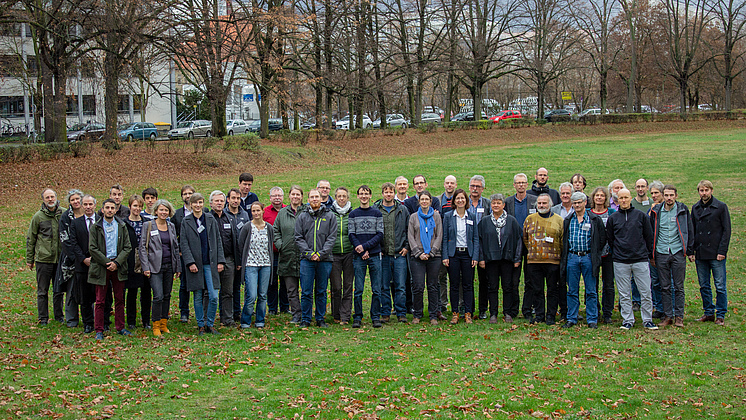Learning from the past, looking into the future: a joint endeavour

The workshop carried out in the framework of the Project "sMon- Analysing trends in German Biodiversity Data" in December 2018 was a great experience to all participants. A total of 48 people form federal state organisations for nature protection, natural history societies, museums, universities and research institutes came together to evaluate the work that has been carried out in the past year. The sMon team proposed new ways and methods to evaluate existing data on biodiversity in Germany. Those data were manifold, originating from various sources, following different purposes, original aims as well as sampling protocols.
For example, ways were demonstrated, how to combine different schemes of biodiversity mapping, e.g. biotope mapping and grid mapping, to derive trends in plant species distribution (see talk by F. Jansen below). Such types of data are, in the case of biotope mapping, typically collected by federal states and grid mapping is a means to produce distribution atlases.
Further, methods to use repeated surveys were introduced. Repeated surveys may comprise repeated biotope mappings carried out by federal states - often with substantial changes in the biotope keys as well as in the sampling protocols. Using external information, such as the Beals metric of co-occurence probabilities can be used to fill potential gaps in species information due to varying definitions of biotopes, thus allowing to deduce trends or changes in species occurrence probabilities is re-mapped biotopes, also accounting for the change in area of such biotopes (see talk by H. Bruelheide below). Other, extremely valuable types of resurvey data come from highly resolved and standardized resurveys of vegetation relevees, perhaps the gold-standard to investigate changes in plant species as well as populations. Although rare, such datasets allow not only to assess changes in the occurrence of plant species, but also changes in their abundances, and thus are able to function as a potential early warning sign of changes in plant populations (see talk by U. Jandt below).
Another extremely valuable source is occurrence data, often collected by nature enthusiasts, private or organised in natural societies. Based on the example of dragonflies, occupancy-detection models were introduced to show trends in dragonfly occupancy in five federal states. Such methods are well-suited to integrate the meticulous work of volunteers into evaluation of the state of nature, in Germany and elsewhere (see talk by D. Bolwer below).
Also occurrence-only data without a direct project reference can be evaluated by modern methods. Thus, a method was presented which is suitable for tracking the distribution status of over 2500 plant species throughout the Federal Republic over the last 60 years. In close cooperation with the Federal Agency for Nature Conservation, the sMon project presented a comprehensive analysis.
The potential of the data available in Germany as well as the modern methods available to evaluate such data led the consortium of the sMon stakeholders, representatives of all sorts of individuals and organisations engaged in the assessment of the state of nature in Germany, to formulate a clear statement to readers outside of the project. In an joint article explicitly addressing data owners, data holders and data curators as well as enthusiastic private persons, more than 40 authors aim at clearly outlining the potential of (sometimes hidden) datasets that might be acquired by stakeholders in Germany. Different methods of analysing such data will be presented, illustrated by comprehensive examples. Means of e.g. digitizing data available in analogous spreadsheets will be presented as well as a rough estimate of effort to do so (e.g. time, money). Finally, the participants of the workshop agreed on the high potential of evaluating the available data for changes in species distribution, abundances and occurrences in retrospect and its power to gain insights in how future designs of monitoring can be complemented by the available information. The talks that were given at this workshops a re available for Download below (most of them in German).
The sMon team is grateful for the good and productive working atmosphere in this workshop.
Thank you all!
Talks for download (most in German):
2. David Eichenberg (iDiv, sMon): Trendanalysen für floristische Daten in Deutschland
3. Diana Bowler (iDiv, sMon): Libellen-Trends seit 1980
6. Klaus Henle (UfZ): Trendanalysen Amphibiendaten - Stand der Untersuchungen
8. Andrea Andersen (BUND): Das Rettungsnetz Wildkatze & auf Spurensuche nach dem Gartenschläfer
10. Roel van Klink (iDiv): Globale Trendanalysen von Insektenpopulationen/ Gemeinschaften
11. Thomas Fartmann (Universität Osnabrück, DGfO): Heuschrecken - Verbreitungstrends in Deutschland
12. Ortwin Bleich (ColKat): Verzeichnis und Atlas der Käfer Deutschlands
16. Samuel Rauhut (LfU Bayern): Arterfassung am Bayerischen Landesamt für Umwelt
17. Bernd Trockur (GdO, Delattinia, LUA Saarland): Libellenerfassung im Saarland
18. Florian Theves (LUBW): Das neue Insektenmoitoring Konzept in Baden-Württemberg
19. David Eichenberg (iDiv, sMon): Advances in plant trend analyses (in Englisch)
